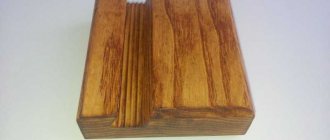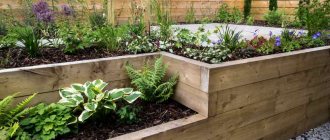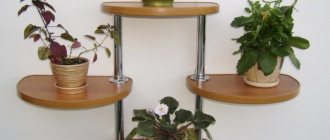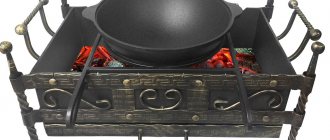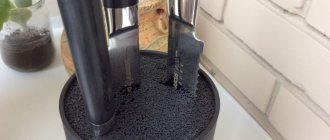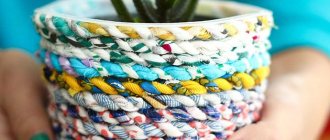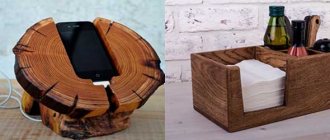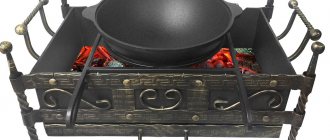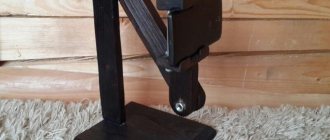An excellent interior design addition to any residential building is the rational arrangement of indoor plants.
Such green spaces will fit perfectly into any design, will delight the owners with their appearance and filter the air in the room.
An excellent alternative to the usual placement on window sills is to install auxiliary retaining structures below.
When there is a shortage of window space, a floor-mounted wooden flower stand is an optimal and budget-friendly solution that, by making it yourself, allows you to not only save money, but also to dilute the ambience of the room.
Peculiarities
The use of green spaces in residential premises has its roots in ancient times. As soon as a person realized the need to build a place in which he could live for a long time, the path of evolution of the interior within this space began. In addition to the appearance of furniture and necessary household items, flowers and useful plants began to appear in the house.
Since there was no medicine as such in ancient times, people were well versed in the healing properties of herbs and flowers and tried to keep them to themselves.
There are a number of beneficial properties that a person receives if they have green plants in their room:
- normalization of a person’s psychological state;
- indoor air purification;
- protecting your home from unknown forces.
In addition to the undeniable benefits, having flowers in a variety of colors at home decorates the room, making it brighter, pleasant and cozy. There are no clear limits on how many flowers there can be in a room, but if you want to have them in sufficient quantities, you should take care of the place where they will be located.
Since plants have certain needs, it is important to provide them with the necessary amount of light and moisture, otherwise they will not live long.
The most common place where pots are usually displayed is the windowsill, but this is not always convenient, so having specialized stands at home can significantly improve the situation.
Such products can be found in the store or you can make them yourself if you try a little.
Primary requirements
In order for stands for indoor plants to be comfortable, fit into the design of the room, and not interfere with free access to windows, it is important to take into account a number of criteria when choosing in an online store or when making your own. Take into account:
- how many indoor plants are in the room;
- lighting level - how far away the window is, configurations and sizes;
- the mass and diameter of the flower pots themselves;
- the direction of plant growth - some of them grow in breadth, while others grow only vertically, to the sides, or hang down in vines.
It is important to make a plan for placing stands so that not a single plant is left without sunny color. It is taken into account that some plants are photophilous, that is, the sun's rays fall at right angles, while others can grow in the shade of others.
There are also safety requirements. No matter how modern the stand is, it is important that it provides reliable support for the flower. It is better to give preference to options whose ends are rounded rather than sharp. This is true if there are small children or pets in the house.
Kinds
Since not everyone can or wants to place flowers on the windowsill, there is a need to select the optimal place for them. At the moment, there is a fairly wide variety of stands that can fit in any room.
Among the most popular options:
- wooden;
- metal;
- combined;
- floor;
- wall-mounted
For indoor plants, any of the above options may be suitable, both in terms of material of manufacture and location. You can make wooden coasters yourself, since only a specialist or a person with experience in such a matter can work with metal.
A DIY wooden flower stand can have a different appearance, which depends on the number of plants that will be placed on it.
If there are a lot of pots, then a multi-level design would be the best option. For one or two flowerpots, you should choose something elegant and stylish to decorate the room.
Independent construction of a product may include the use of a wide variety of materials:
- pieces of plastic;
- twine;
- wire of different thicknesses and colors;
- vine;
- threads
The stand does not have to be simple; it can be stylishly decorated and complemented with mosaics, decoupage or painted.
Before you start making the product, you should consider the option of the stand, its height, dimensions, sketch out drawings and decide on the final option. In the process of work, certain ideas for decorating an object usually emerge, but sometimes a ready-made form suggests the desired option, so there is no need to rush with it.
If a floor design has been chosen, then it is worth choosing the most suitable option. It could be:
- ladder;
- multi-level shelves;
- apartment flower bed;
- high stand;
- low stand.
The floor version is also called jardiniere. It is often used as a decorative element. It is not difficult to make such a design, you just need to choose a material that is convenient for the work.
Usually this is chipboard, wood or plastic, from which the stand itself and the base are made, connecting to each other. The stand can have any height, the main thing is that the entire structure is stable, for which the base must be at least 20 cm in diameter.
When creating a jardiniere, it is necessary to provide grooves, thanks to which all the parts will be connected, and to use specialized glue for reliable fixation.
Wall stands are usually created in the form of one or more shelves that connect to each other. This option is used in cases where there is no space on the windowsill or floor for additional objects. Most often, wall shelves are made of metal or wood. The most beautiful techniques are forging and figured wood cutting. If we talk about more affordable options, then these include connecting one shelf with sides or several shelves with membranes that will strengthen the structure.
You can also come up with a variety of stands for the window that will make the room more comfortable and beautiful, and also make it possible to place many more flowers in it. When thinking through the design, it is important to provide several important details:
- free access of light to the room;
- ease of use of the window sill;
- comfortable watering and care of flowers;
- the opportunity to admire the vegetation from anywhere in the room.
Wood, plastic and metal are most often used for window sills. The most beautiful stands are made of metal, with the help of which amazing things are forged.
Wooden and plastic products are less attractive, but more practical, because with their help you can make a small but high stand that will accommodate from 4 to 8 pots. The most popular option is to combine round wooden stands and a metal stand, which ensures the strength of the structure and its neat appearance.
The choice of option depends on the size of the room, the number of colors and the desires of the owner. You can make any stand with your own hands, the main thing is to understand the principles of its manufacture, select the right materials and make a suitable drawing.
When choosing a product for a room, you should also focus on the general style of the room, so that the new object complements it and does not stand out from the already finished concept.
The final stage is decoration
By creating a shelf, you can create your own product design. By choosing the right materials and taking a little time, you will get a unique masterpiece!
- For example, a plastic product comes in different colors. For an original design, you can attach decorative handrails.
- The wooden shelf is painted with sequins. This gives the product shine and shine.
- Glass shelves are often decorated with patterned metal elements.
Also, for a craft to become beautiful, it is not necessary to paint it or attach anything to it. Just place vases and beautiful stones, toys, shells on it. In addition, furniture can be decorated with various fakes and toys.
Don't be afraid to experiment! Create new masterpieces and improve your skills! An indoor planter is just the beginning. Nothing brightens up your home like handmade items.
How to make a flower stand from various materials
What options are there in terms of materials used? The simplest and cheapest is plastic. Plastic coasters are presented on store shelves in a large assortment. It is not difficult to choose any color and shape.
Plastic structures can be floor-mounted or suspended. But they have one significant drawback - they cannot withstand a lot of weight and are only suitable for medium-sized pots.
On sale you can also find models of flower shelves made of MDF or chipboard.
Rattan products look very decorative. The interlacing of the stems of this tropical palm tree is often decorated with leather and other natural materials. It all looks quite decent. But such products also cost a lot.
Glass stands can be called a universal choice. For this purpose, not only transparent, but also colored tempered glass is used.
But all of the options listed are industrial products. What can you use to make your own flower stand?
Advantages of mobile structures
Any flower must be turned towards the light at regular intervals for optimal stem growth and crown formation. In addition, regular cleaning of premises requires the ability to move plants in order to remove fallen leaves and other dirt.
The use of mobile structures will help smooth out the inconveniences that arise when solving the described issues.
These include the following models:
- Whatnots.
- Floor platforms and platforms.
- Small tables with movable casters.
The main advantage of such products is the ability to move them freely around the perimeter of the room. The use of such devices is especially important in older people, when it is extremely important to optimize physical activity as much as possible.
Moreover, an excellent addition to mobile models would be the installation of wall brackets with hanging shelves or flowerpots.
Floor platforms allow you to move large flowers, while simultaneously changing the visualization of the internal space.
The main purpose of compact multi-tiered structures and shelves is to accommodate small flowers and seedlings. For more developed plants, it is important to use more spacious stepped products.
When purchasing mobile structures, emphasis should be placed on weight load limitations. Ignoring this rule may subsequently become, at a minimum, the cause of breakdown of the movable rollers.
DIY flower stand made from cut wood
The most common and affordable base for making such a stand is natural wood. There are many advantages to this choice. Firstly, you will be one hundred percent confident in the reliability of the wooden structure. And secondly, wood can be decorated in different ways: covered with stain, varnish, or simply painted in any color.
Such original and stylish flower stands will fit into most interior styles and will go well with natural furniture.
An example of how to make a wooden flower stand with your own hands:
- To create an original stand, you only need a large tree root and a couple of saw cuts of a suitable diameter. The root must be cleaned of all rotten parts
- The bark on saw cuts should be removed. This is not difficult to do with a regular chisel.
- The side parts, freed from bark, are sanded with a brush manually or using a drill.
- The top of the cut must be perfectly flat so that the flowerpots with flowers stand stable.
- On the upper parts of the root, make flat areas for attaching cuts
- To ensure reliable fastening, the area under the cut is first glued with PVA glue
- And after gluing, the saw cut is additionally fixed with a pair of screws on top
- Use self-tapping screws in side fastenings as well.
- When the stand is ready, coat it with oil, wax or varnish - whatever you like best
- An unusual flower stand will decorate your garden or home
- This DIY wooden floor flower stand will last your family indefinitely.
Examples of the work of folk craftsmen
Simple wooden shelves that are attached to ropes are popular. A distinctive feature is the recesses for the size of each pot. Fits perfectly into eco or country design. In order to make a stand, you will need:
- take three wooden shelves of the same size;
- drill identical holes in them;
- make beams or brackets;
- fix the rope knots after leveling the boards.
Small shelves are often used to decorate a home. The advantage is that the length of the ropes can be adjusted, so you can put them after as many wooden shelves as you like. You will need:
- select several shelves and make 4 different holes in them;
- tie with ropes and make knots for support;
- connect the ropes at the top and secure them.
You can decorate such an unusual piece of furniture with different details. For example, choose a thick, beautiful rope and learn how to weave it in macrame style. Or shade the brushes below, paint the boards themselves in different colors.
Garland stands are in demand for decorating small modern rooms. They look beautiful with high ceilings. The peculiarity is that the shelf is narrow, for one pot. Each board is made square, a circle is cut out in the middle, and there are four holes on the sides. Ropes are passed through them and secured with knots. They are tied from above and attached to the ceiling.
But the most permanent option that will decorate any room is a floor stand for one flower. It consists of a base, a leg, a thrust bearing and the stand itself. Any shelf you create yourself will cost significantly less than one bought in a store.
In addition, the process is simple, so even a person who is little familiar with the nuances can cope with it.
How to make a metal flower stand with your own hands
Metal flower stands can be made entirely of steel or used in combination with wood, glass or MDF. All-metal structures are especially impressive using the forging technique, when you can give them intricate shapes and decorate them with many decorative elements.
Here's how you can create a simple design without any special skills in working with metal:
- To make a simple shelf you will need a pair of stainless steel pipes, fasteners corresponding to the diameter of these pipes, and shelves that can be made from chipboard or natural wood
- It is better to round the corners of the shelves so that they do not accidentally injure anyone
- At the same distance on both edges of each shelf you need to make holes corresponding to the diameter of your racks
- If you took a base for chipboard shelves, then treat the edge with a special adhesive-based welt or a plastic one like this
- Secure the fasteners over the finished holes using self-tapping screws
- All that remains is to “dress” the shelves on the metal and arrange them at the desired height
- Place this simple flower stand on the floor or table
Step by step guide
To make a wooden stand with your own hands, you need knowledge and some experience in working with tools and materials. Even if you are creating such a product for the first time, you should not worry, because any work done from the heart will look interesting, and the knowledge and skills gained will help in the future.
So, to build a flower stand, you need to take:
- wooden boards or plywood, the thickness of which will exceed 1 cm;
- a large diameter cord or rope that will serve as decoration;
- a drill with a drill whose diameter matches the thickness of the cord or rope;
- sandpaper;
- varnish/paint.
The parts for the future shelf need to be cut into square or rectangular shapes. On each shelf, holes are made along the edges with a drill, departing about 5 cm from the edge. The next step is to measure the required length of the rope. To determine it, you need to multiply the length of the shelf by two and add another 25 cm. On each piece of rope, determine the middle at which the knot is tied.
The ends of the rope are threaded through the first board, aligned in the center and secured with new knots, which are located above the holes. Next, the height of the new shelf is measured and bridles are created to support it. Such a shelf turns out to be suspended; it can be placed both on the wall and under the ceiling.
- If you want to make a strong floor stand, then you should prepare a saw or hacksaw, a screwdriver, self-tapping screws, 5x5 cm wooden blocks or a piece of branched wood. The height of the stand is selected according to taste and capabilities. The structure itself can be double-sided or wall-mounted, when the racks will diverge to the sides rather than go around the support. It will be necessary to attach shelves on which the flower pots will be located on the racks. It is important to place the supports so that the flowers stand at different heights, imitating a natural slide, which looks very impressive and beautiful in the interior.
- Having measured the required length of the supports, you need to cut them diagonally in the place where they will be attached to the base. To make the structure more durable, it is better to use a cross member when connecting. All parts can be connected with nails or self-tapping screws. You can use a metal furniture corner.
- Once the stand is completely ready, it must be varnished or painted.
Tools
To work with wood and metal you will need the following devices and tools:
- Level;
- Roulette;
- Screwdriver;
- File;
- Jigsaw;
- Screwdriver;
- Hammer;
- Welding machine (for metal elements);
- Construction pencil.
When choosing fastenings, proceed from the position that the more weight the structure must withstand, the better and more powerful the fastening you select.
Buy or make it yourself?
Perhaps every housewife asked herself this question. Today, a huge assortment of all kinds of decorative forms, stands, holders and supports is available. The only problem is that truly beautiful accessories are not cheap and not everyone can afford them. And what is affordable is not always pleasing to the eye.
Another advantage of “hand made” products is that they can be made to the desired size. If there is a small corner between the sofa and the armchair left for a flower stand, or a fragment of the wall near the closet is ideal for a shelf, then by carefully measuring the space, you can create a neat and very practical interior detail.
Moreover, today you can purchase various accessories, decorative elements and fasteners, so that the item is beautiful and as functional as possible.
Manufacturing rules
Manufacturing rules depend on the type of flower. Large stands are made for solitary flowers that do not like being next to other plants. Single stands are made in round or oval form, stable or mobile (equipped with wheels for moving around the apartment).
Making the shelves will take more time, but in this case the plants will be placed depending on their light-loving nature and desire for watering. Convenient for a small apartment, as they save space.
Tabletops are also easy to make; they are suitable if there are 2-3 plants in the house that do not have a dense crown and are not prone to strong growth.
By placing plants on the tabletop at different levels, you can ensure that each of them receives the required amount of light and it will be convenient to water them.
Vertical stands with planes of different sizes, popularly called towers, will also allow you to conveniently place your favorite flowers and save space. The advantage of such options is that you can additionally install rings under the pots. But proportionality must be observed, otherwise the tower will collapse under the weight of one side.
The slides resemble towers, but the pots are on vertical stripes. The slide can be easily re-tightened if more light is needed. However, the design is unstable, so it is not suitable for families with small children.
See also
Rules for decorating a hallway with decorative stone, ideas for decoration and design
Ideas for making flower stands with your own hands
A plant stand is a must if you keep indoor plants, as sooner or later you will run out of room for them on your table or counter. Making your own plant stands from wood gives you the opportunity to reuse used materials while adding a natural ambiance to your home decor.
A yard sale or thrift store rescue can be a good source of inexpensive materials for making plant stands if you don't already have those materials in your home.
Simplicity of a stepladder
A small wooden stepladder with two or three steps can serve as a cute, slightly distressed plant stand that doesn't require any modifications. Turn it into a colorful distress by first painting a base shade, such as apple green, rubbing candle wax onto the dry paint, and then applying a second shade on top, such as robin's egg blue. Sand some areas to expose the underlying color and expose the wood.
Two short stepladders with a wide board between them serve as a wide plant stand.
For a tall stand, remove the back half of a tall wooden stepladder and lean the ladder against the wall so that the top platform is level. The bottom of the stepladder will protrude from the wall about a foot, and the top will touch the wall. Attach the top of the ladder to the wall using L-brackets and wall anchors.
Box design
A row of wooden crates or boxes, such as wine crates or antique fruit crates, placed next to each other with the open ends facing the room, can serve as a plant stand. Arrange the drawers in the configuration you want. Create a pyramid-shaped plant stand along the wall by stacking tiers of boxes, such as a base of three boxes, a layer of two, and one in between.
Potted plants are placed both inside the openings of the boxes and on top of them, which provides plenty of space for plants.
Mix plants and decorative items, such as empty vases, among the boxes for added visual interest. Even a single box placed in a corner or near a table can provide a place to place a plant if space is limited. For the safety of children and pets, make sure the boxes are strong enough to support the weight of your houseplants and that they are positioned so that they cannot be knocked over.
Flower stands with legs
Cutting boards of almost any length can become plant stands if you add wooden legs, latches or porch railings to them. A board at least a few inches wide and an inch thick is the most versatile stand because it can support even wide or heavy plant pots.
Table leg sets, complete with hardware, can be purchased at home improvement stores.
A wooden serving tray with extra legs serves as a plant tray that will fit into even a small space, while an old pantry or closet door can accommodate several potted plants. As for the length of the legs, it is a matter of choice. Tall legs create a stand where plants can receive ample sunlight from a tall window.
Hanging
A ceiling hook may be a common place to hang a plant basket, but it's not the only option. Make a rectangular wooden frame several feet tall using boards of equal width held together with screws or L-shaped brackets. A wider wooden board attached to the bottom of the structure strengthens the stand and makes it more durable. A plant hook under the top board can hold a hanging basket.
From plywood
- The classic stand is well suited for apartments and houses. You need to take a shelf made of chipboard or PVC, plywood, thick rope, screws, plugs, paints and varnish for decoration, a screwdriver, drill, saw, hammer and screwdriver. For comfortable work you will need a level, tape measure, ruler and pencil. Make the product like this.
- Prepare the material. Calculate the size based on the free space. The width should match the size of the pot. Additional bars in the middle will help make the distance between the shelves the same.
- Drill 2 holes in each shelf with a drill. They need to be placed in parallel. The size of the hole should be such that a thick rope can pass freely.
- Pass the rope through all the holes. Form a loop at the top for hanging, and make a secure knot at the bottom.
- Install the stand. Drill a hole in the wall in the desired location and install the mount. Fix the stand firmly. The wall design is ideal for indoor plants.
From wire
Even a woman can make a structure, the main thing is to have experience in handling cold welding. For work, use welding wire with a diameter of 1 cm. Stock up on cold forging tools and a hammer (800 g). Make a stand like this.
- Draw a sketch, divide it into simple parts. Calculate all sizes. Be sure to consider the diameter of the round blanks for the pots.
- First of all, make a stand and stands. Duplicate the drawn parts with wire and secure with cold welding.
- Make decorative items. These can be various curls, spirals, leaves and flowers. If desired, you can use ready-made metal molds to create these parts. Simply drive the wire into the template with a hammer and remove the desired element.
- Attach all the decorative parts to the main homemade structure using cold welding.
Tabletop flower stands
Cute table stands are widely used in apartments with limited space. They are placed on tables, cabinets, shelves near a source of daylight. They also come in a wide range of forms.
The compactness and small dimensions of such racks provide more scope for creativity. They are made mainly from wood, plastic, twisted metal profile, chipboard, and also woven from any flexible material that is at hand (wicker, rattan, bamboo).
Wooden for bathroom flowers
A wooden shelf is suitable for a bathroom, but in order for it to last longer and not become a breeding ground for harmful bacteria in the room, you need to coat it with varnish.
From the stairs
In its usual form, it would be awkward to install a staircase shelf; in no case would the solution fit into the design of the home.
But if the staircase is refined, it can become a stylish stand for several pots of flowers.
First you need to sand it, and then remove the boards intended for walking. They are fixed inside the structure.
Sliding rack
It is quite difficult to create a sliding rack with your own hands. To do this, you will need to cut out various square elements and connect them in the form of a snake. It is important that the structure does not settle after assembly (this happens when using wooden elements).
Corner semicircle
A corner stand in a semicircle, which is mounted on the wall, will save useful space in the room. You will need several meters of MDF and a milling machine. Three elements are cut out: two sides and a bottom, and the shelves after. If you stick tape on the ends of the product, the stand will become more beautiful.
On belts
A wall shelf with straps does not have much durability. But it can become a stylish decoration for the interior of a room. To make it you only need two boards and two belts. The shelf is simply placed on the belts, and they are secured with self-tapping screws on the wall.
Glass
The glass shelf will fit into the interior of any room. Glass strips are attached with wooden blocks; you can make a flying version.
Combined
The combinations can be very different. Often made from driftwood and metal, wood and pipes. There are even options made from glass bottles and popsicle sticks. The main thing is to take into account the requirements for sustainability.
Drawer construction
In this case, you won’t have to tinker with anything. Several boxes of any size (same or different) are painted in a suitable color. After the composition has dried, the objects are placed on top of each other in random order (large ones on the bottom, smaller ones on top).
For greater reliability, all elements are fastened with self-tapping screws. Flower pots are placed in the resulting niches and at the very top of the structure. Such a wall-floor stand will take a minimum of time, but will look quite interesting.
Pallet flower stand
This version of the stand is more suitable for a summer house, but after careful processing of the pallets it can be “fit” for an apartment. Even one pallet is suitable here, which is placed vertically, with the help of self-tapping screws, crossbars and shelves for flowers are screwed to it.
The second life of familiar objects: unusual stands for plants
If you don’t want to make racks using a set of tools and purchased materials, take a closer look at the items you have on hand. Among them there are those that can turn into a flower stand.
Bird's cage
The fancier the shape of the cage that has become a stand for plants, the better. Antique bird houses are ideal, and if you place flowers climbing along the rods in them, you will get exclusive interior decor.
Elegant cage stands
Ladder
A sliding A-frame ladder with wide steps is a ready-made stand for house plants. If the steps are narrow, then place boards of the required size on them. Does this option seem boring? Using your imagination, you can use a ladder to make a ceiling frame for hanging flowers.
If you don't want to cut down a tree, use a ladder as a stand
Cornice
To avoid drilling holes in the window opening when arranging hanging stands in it, make a miniature airy flowerbed from a cornice. Secure flower pots to it using thin metal chains or ropes. A cafe curtain covering the lower half of the window will help hide your home from prying eyes.
Luxurious bronze plant hangers
The flowers on the cornice will definitely get enough sun
Fireplace
Rare types of flowers will withstand long-term placement on a real fireplace. But plants will become a harmonious filling for a false fireplace. Flowers are hung on a metal lattice, placed on the mantelpiece or inside the portal.
Flowers on the mantelpiece
Old kitchen chest of drawers
Flower pots in close proximity to dishes are a dubious idea. But the chest of drawers, which is no longer used to store cups and plates, will become a spacious stand for plants. If necessary, it will be possible to provide additional lighting for flower growth.
Furniture filled with flowers will not be ignored
Hooks
Any vertical surface or railing can become a stand for plants: just attach metal hooks to it, from which you hang pots.
Hooks allow you to change the arrangement of plants on the stand base
Cords and ropes
Mastery of the macrame technique opens up wide possibilities for creating hanging stands for plants. To make such products look current, knit them from multi-colored cords or fit them into interiors as spot vintage elements. If you have no skills in macrame, tie hangers from several crossed ropes.
Rope hangers for home flowers
Making coasters is an important matter, but it is no less important to harmoniously fit them into the surrounding environment. Find out more about how to combine flowers and interior style.
